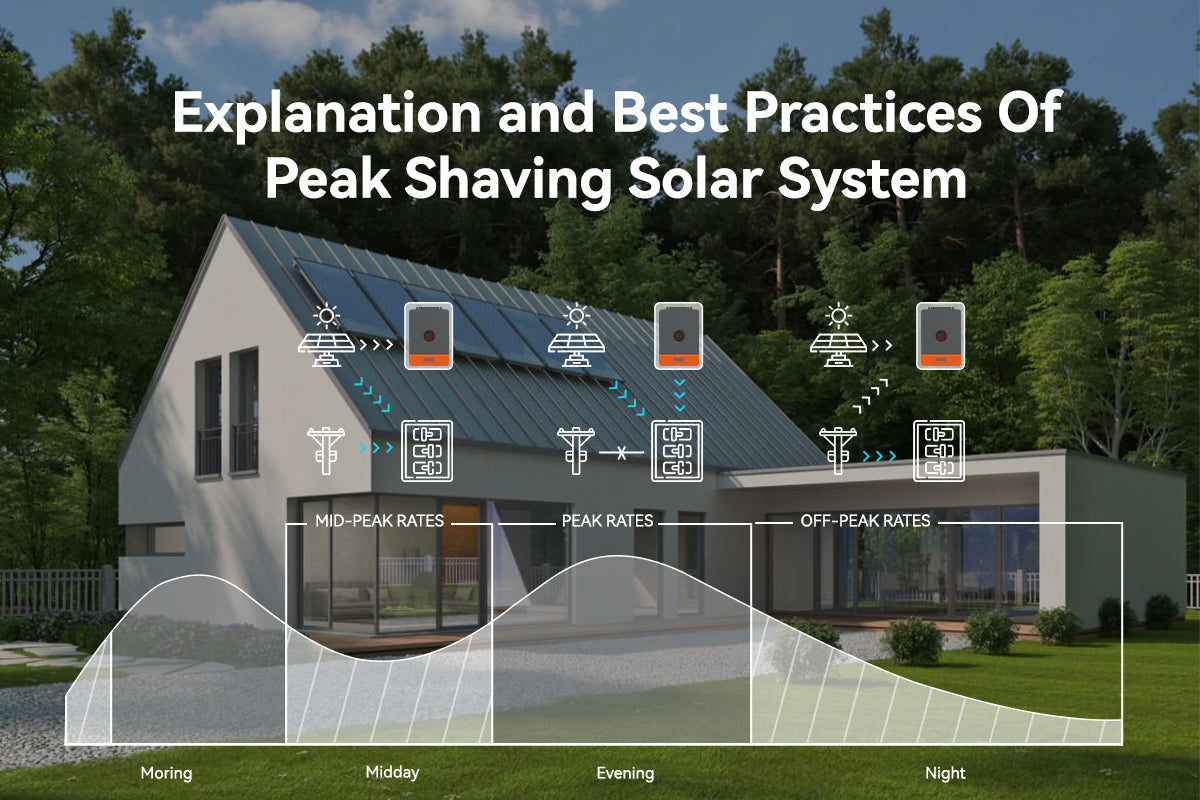To balance power supply and demand and alleviate grid pressure, utility companies continually introduce innovative rate structures to meet the needs of residential energy consumers. The common goal of these efforts is to incentivize energy consumption when generation costs are low and curb energy usage when costs are high.
Time-of-use pricing, also known as time-of-use rates, is a widely employed tariff system. According to EU Agency for the Cooperation of Energy Regulators,21 European countries (i.e., 75%) adopt time-of-use tariffs, while 7 countries (BG, CY, DE, HU, IT, LU, RO) do not use them.

Time-of-use pricing operates by varying electricity rates throughout the day, with lower rates during off-peak hours and higher rates during peak hours. This encourages consumers to shift their energy usage to off-peak periods, reducing peak demand and grid stress, a concept known as "peak shaving".
In this blog post, we will delve into the significance of peak shaving in solar systems and explore best practices to make the most of this innovative approach.
What is Peak Shaving and how does it work
Peak shaving is a strategy employed in the realm of solar power management to maximize the utilization of energy generated by solar panels during specific time periods.
Peak shaving involves reducing electricity usage from tne grid during periods of high demand, typically during peak hours, to lower energy costs and minimize strain on the electrical grid. This is often achieved by temporarily cutting back on non-essential processes or switching to alternative energy sources.
"Valley Filling" is employed alongside "peak shaving" to realize the full potential of solar systems. It entails the repositioning of the grid's high-demand peak of power consumption to low TOU rates periods, such as late at night. This strategy takes advantage of lower electricity prices during off-peak hours and optimizes the use of excess energy that might otherwise go to waste.

By combining peak shaving and valley filling, consumers can effectively level out their electricity demand over a 24-hour period, benefiting both themselves and the grid. This approach not only reduces energy costs but also enhances grid stability, minimizes environmental impact, and promotes energy independence.
The Best Practices for Designing and Operating a Peak Shaving System
One of the most critical aspects of peak shaving is the integration of battery storage. Batteries are pivotal in storing excess energy generated during off-peak hours for use during peak demand periods. They act as a buffer, allowing you to shift your energy usage and reduce your reliance on the grid when electricity costs are higher.
In order to implement an effective peak shaving strategy within a solar system, it is advisable to incorporate the following best practices:
Assess Load Profile and Time of Use Rate
Achieving peak shaving requires careful consideration of two crucial factors: the load profile and electricity rate schedules.
Load Profile
To begin, it is essential to conduct a comprehensive analysis of the electricity consumption load curve. This analysis will help you understand how energy usage fluctuates at different times of the day.
By examining this data, you can pinpoint when the peak load occurs and determine the exact amount of energy required during these peak periods.
Electricity Rate Schedules
Additionally, it's important to have a clear understanding of your utility's time-of-use (TOU) rate structure. TOU rates involve varying electricity prices throughout the day, typically with higher rates during peak hours and lower rates during off-peak hours. This knowledge is invaluable for optimizing your energy management strategy.

By understanding these rate variations, you can make informed decisions about when to use or store energy.
Set Up a Peak Shaving System
With a thorough understanding of your load profile and TOU rate structure, you can now set up your peak shaving system.
Operate a solar system can be tailored to different goals and user groups depending on their specific needs and preferences. Here are some scenarios and user groups that might lean towards "Self Consumption with Zero-Export" or "Self-Consumption Surpluses"
Option1 - Peak Shaving for Self Consumption with Zero-Export
Peak shaving for self-consumption with zero-export is a strategy that focuses on maximizing the use of solar-generated energy within your property without exporting excess energy back to the grid. The goal is to consume as much of the energy you produce as possible, especially during peak hours, to reduce your electricity costs and minimize grid strain.
Current Transformers are a key component for monitoring energy flow. By installing CTs, you can measure the electricity consumption and generation, allowing for precise control of energy flows.
PowMr Peak Shaving Inverter, equipped with CT, can be instrumental in this strategy. It helps monitor your electricity consumption in real-time and ensures that you don't export excess energy to the grid.
Take, for example, the SunSmart 10K model. With the time-slot charging and discharging setting function, you can set the time period for cutting in/out of mains charging and switch the time period between battery discharging and mains bypass power supply mode.
It has three definable charging periods and three discharging periods, which is ideal for optimizing energy usage according to specific time-of-use tariff in different region .

With this feature, you can set up a battery storage peak shaving solar system that does not feed back to the grid:
Peak Shaving - Determine the Battery Discharging Period
- According the local TIME OF USE schedule, find out the peak hours and designates them as the "Battery Discharging Period".
- During this time, the inverter's primary task is to draw power from the battery to meet the load demand, with grid power being the last resort.
Vally Filling - Control the Utility Charging Period
- Based on the local TIME OF USE schedule, determine the time period with the lowest electric bill and set it as the "Utility Charging Period".
- During these periods, the inverter prioritizes utilizing solar energy to meet the load demand and charge the battery.
- Only when solar energy is insufficient does the inverter draw power from the grid, ensuring the acquisition of electricity at the lowest possible cost and striving to minimize the electricity obtained from the grid.
Through this energy management strategy, the intelligent inverter can minimize electricity costs, secure power during off-peak periods, and maximize the utilization of solar energy and energy storage systems, thereby reducing reliance on the grid.
This approach is commonly adopted by different user groups:
-
Residential Homes
Homeowners who prioritize reducing their electricity bills and self-sufficiency often adopt this approach. They use energy during the day and store surplus energy in batteries for use during peak hours. -
Off-Grid Properties
Properties not connected to the grid or with unreliable grid access rely on this approach to ensure a continuous power supply. -
Net Metering Restrictions
In regions with limitations on net metering or low export tariffs, homeowners prefer to maximize self-consumption.
Peak Shaving Solar Inverter with Battery Storage - Video SetUp Guide
Option2 - Self-Consumption Surpluses
Self-Consumption Surpluses is a comprehensive solar energy strategy. Once your peak shaving system is set up and optimized for self-consumption, the surplus energy generated can be seamlessly integrated into the grid. This strategy typically involves some complex processes:
-
Assess Grid Feed-In Opportunities
Start by evaluating your local regulations and utility policies regarding grid feed-in. Ensure that your solar system is approved and commissioned for grid interaction. Compliance with safety and technical standards is essential. -
Optimize System Capacity
To effectively balance peak shaving and grid feed-in, you need to optimize your solar system's capacity. Ensure that it aligns with your energy needs and your local grid's requirements. -
Inverter Selection
Choose inverters equipped with grid-feed features. These inverters should support seamless energy export to the grid while maintaining control over peak shaving. The PowMr Grid Tie Inverter, mentioned earlier, can be an excellent choice. -
Synchronized Operation
Similar to Option1, coordinate the operation of your solar system with time-of-use rates. -
Compliance and Reporting
Ensure that you adhere to all local regulations, including safety and environmental standards. Keep accurate records of energy production, consumption, and grid feed-in for reporting purposes.
This strategy is comparatively more complex than the previous one, involving an initial investment, the need for technical expertise in system setup and maintenance, and potential limitations due to grid capacity and network congestion.
Therefore, it is better suited for the following scenarios:
-
Commercial and Industrial Facilities
Businesses with larger solar installations often generate more energy than they consume during the day and sell excess energy back to the grid, creating an additional revenue stream. -
Utilities and Grid Operators
Utility companies use this approach to stabilize the grid by injecting surplus renewable energy during peak demand periods, contributing to grid reliability. -
Government Incentives
In regions with government incentives, tariffs, or subsidies for grid feed-in, homeowners and organizations may opt to contribute to the grid to maximize their financial benefits. -
Locations with Abundant Sunlight
Locations with abundant sunlight and oversized solar installations may naturally produce more energy than can be consumed through peak shaving, making exporting to the grid a practical choice.



